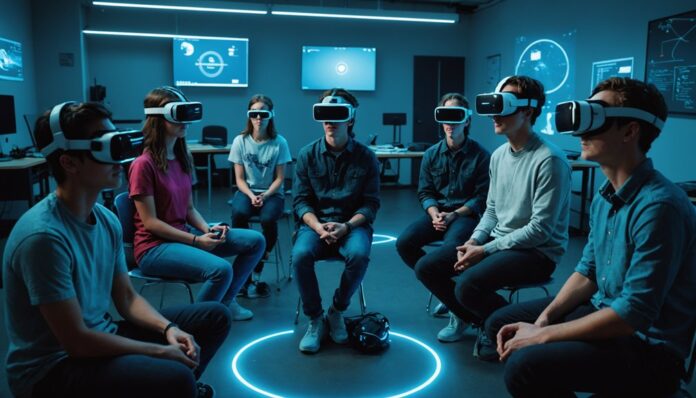Schools are leveraging virtual reality to revolutionize the learning experience. By integrating VR into their curricula, educators can create immersive environments that simulate real-world situations, making complex concepts more accessible and engaging. From virtual labs and interactive 3D models to historical reenactments and global field trips, the possibilities are vast. As schools continue to investigate the potential of VR, one question emerges: what impact will this technology have on the future of education?
Highlights
- Schools are leveraging virtual reality to enhance STEM education, offering immersive experiences for student engagement and hands-on practice in programming languages.
- Virtual reality brings history to life through historical reenactments and immersive storytelling, fostering a deeper understanding of historical events and figures.
- Virtual field trips using VR technology allow students to explore global destinations from the classroom, promoting cultural immersion and global awareness.
- Interactive 3D models in VR simplify complex concepts, increasing student engagement, motivation, and academic achievement in STEM subjects.
- VR supports students with special needs by providing personalized learning environments, developing social skills, and enhancing academic outcomes through immersive experiences.
Enhancing STEM Education With Virtual Reality
As the demand for skilled workers in science, technology, engineering, and mathematics (STEM) continues to grow, educators are turning to innovative tools to enhance student learning and engagement in these subjects.
Virtual reality (VR) is becoming increasingly popular in STEM education, offering immersive and interactive experiences that simulate real-world environments. Virtual labs, for instance, allow students to conduct experiments and investigations in a controlled and safe setting.
Coding simulations, on the other hand, provide students with hands-on practice in programming languages, enabling them to develop problem-solving skills and critical thinking.
Bringing History to Life Through Immersive Experiences
While traditional teaching methods often rely on textbooks and lectures to convey historical information, virtual reality is offering a new way to engage students in the study of history.
By utilizing historical reenactments and immersive storytelling, virtual reality experiences can transport students to different time periods, allowing them to witness and interact with historical events firsthand. This approach enables students to develop a deeper understanding of historical events and figures, nurturing empathy and connection to the past.
Students can investigate ancient civilizations, visit historical landmarks, and relive crucial moments in history, making the subject more accessible and enjoyable. As a result, virtual reality is helping to bring history to life, making it a more immersive and memorable experience for students.
Virtual Field Trips: Exploring the World Without Leaving the Classroom
By leveraging virtual reality technology, schools can now offer students the opportunity to commence virtual field trips, exploring destinations around the world without ever leaving the classroom.
This innovative approach enables students to experience different cultures and environments in a highly immersive and engaging manner. Virtual field trips facilitate cultural immersion, allowing students to gain a deeper understanding of diverse customs, traditions, and ways of life.
Additionally, these experiences promote global awareness, encouraging students to appreciate the interconnectedness of the world and its intricacies. By participating in virtual field trips, students develop empathy, tolerance, and a broader viewpoint on global issues, ultimately becoming more informed and responsible global citizens.
This technology has the potential to transform the manner in which students learn about the world and its diverse populations.
Interactive 3D Models for Deeper Understanding of Complex Concepts
How can educators employ technology to simplify intricate concepts and make them more accessible to students? Interactive 3D models offer a solution.
By incorporating virtual reality, educators can provide interactive simulations that allow students to engage with complex concepts in a hands-on, immersive manner. This approach enables students to develop spatial reasoning skills as they manipulate 3D models, exploring and analyzing the concepts from multiple angles.
Interactive 3D models facilitate deeper understanding, as students can visualize and interact with the concepts in a way that is not possible with traditional teaching methods. This approach has the potential to increase student engagement, motivation, and academic achievement, particularly in subjects such as mathematics, science, and engineering.
Using Virtual Reality to Support Students With Special Needs
For students with special needs, accessing educational content can be a significant challenge.
Virtual reality (VR) is helping to break down these barriers by providing immersive, sensory experiences that cater to individual learning needs. By utilizing VR, schools can create personalized learning environments that engage students with special needs on a deeper level.
For instance, VR can help students with autism to develop social skills through interactive scenarios, while students with visual impairments can use VR to investigate tactile environments.
This innovative approach to learning not only enhances academic outcomes but also nurtures a sense of inclusivity and belonging.
Conclusion
Schools are revolutionizing the learning experience through the integration of virtual reality into their curricula. By leveraging immersive environments, interactive simulations, and virtual field trips, students can engage with complex concepts in a more meaningful and inclusive way. From enhancing STEM education to supporting special needs students, virtual reality is reshaping the classroom into an evolving and interactive space that nurtures deeper understanding and improved academic outcomes for all learners.


